Wood Dust Extraction System Market
Wood Dust Extraction System Market Size and Share Forecast Outlook 2025 to 2035
The wood dust extraction system market is projected to grow from USD 1.4 billion in 2025 to USD 2.1 billion by 2035, at a CAGR of 4.1%. Centralized Ducted will dominate with a 40.0% market share, while 2,001–10,000 m³/h will lead the airflow capacity segment with a 40.0% share.
Wood Dust Extraction System Market Forecast and Outlook 2025 to 2035
The global wood dust extraction system market is valued at USD 1,400.0 million in 2025. It is slated to reach USD 2,092.4 million by 2035, recording an absolute increase of USD 692.4 million over the forecast period. This translates into a total growth of 49.5%, with the market forecast to expand at a compound annual growth rate (CAGR) of 4.1% between 2025 and 2035. The overall market size is expected to grow by nearly 1.49X during the same period, supported by increasing workplace safety regulations, growing environmental compliance requirements, expanding woodworking industry automation, and rising awareness of occupational health hazards in wood processing facilities.
The growth of the global wood dust extraction system market is being driven by multiple converging factors across industrial, regulatory, and technological domains. One of the primary drivers is the increasing emphasis on workplace safety regulations. Governments and regulatory authorities across North America, Europe, and Asia-Pacific are enforcing stringent occupational health and safety standards in woodworking facilities, particularly regarding airborne particulate matter and combustible dust hazards. Compliance with these regulations necessitates the adoption of advanced dust extraction and filtration systems to minimize health risks, prevent respiratory issues, and reduce the likelihood of fire or explosion incidents in manufacturing environments.
Environmental compliance is another key growth catalyst. Rising awareness of the ecological impact of particulate emissions, coupled with stricter air quality standards, is compelling wood processing facilities to invest in systems that effectively capture and filter wood dust. Companies are increasingly recognizing that sustainable operational practices not only mitigate regulatory risks but also enhance brand reputation among environmentally conscious consumers and stakeholders.
Technological advancements in automation and smart manufacturing are further accelerating market adoption. Modern wood processing plants are integrating automated production lines with sophisticated dust extraction systems that operate in real-time, providing continuous monitoring and adaptive airflow control. These systems improve operational efficiency, minimize downtime, and allow facilities to maintain cleaner work environments without compromising productivity. Additionally, the development of energy-efficient and low-maintenance extraction solutions is attracting manufacturers seeking cost-effective, long-term operational strategies.
Rising awareness of occupational health hazards among workers is also contributing to market expansion. Facility managers and safety officers are increasingly prioritizing investments in wood dust extraction to prevent chronic respiratory conditions and allergic reactions, thereby enhancing workforce productivity and reducing absenteeism.
Geographically, mature markets such as Europe and North America account for significant shares of the market due to the presence of advanced woodworking industries and stringent health and environmental regulations. Meanwhile, emerging markets in Asia-Pacific are witnessing rapid growth driven by expanding furniture manufacturing, construction, and woodworking sectors. Collectively, these factors indicate a robust growth trajectory for the wood dust extraction system market, positioning it as a critical component of industrial safety, environmental stewardship, and operational efficiency in woodworking facilities worldwide through 2035.
Quick Stats for Wood Dust Extraction System Market
- Wood Dust Extraction System Market Value (2025): USD 1,400.0 million
- Wood Dust Extraction System Market Forecast Value (2035): USD 2,092.4 million
- Wood Dust Extraction System Market Forecast CAGR: 4.1%
- Leading System Type in Wood Dust Extraction System Market: Centralized Ducted
- Key Growth Regions in Wood Dust Extraction System Market: Asia-Pacific, Europe, and North America
- Key Players in Wood Dust Extraction System Market: Donaldson, Nederman, Camfil, Scheuch, Höcker Polytechnik, Plymovent
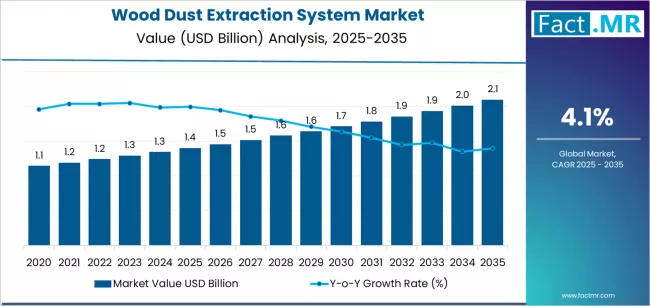
Between 2025 and 2030, the wood dust extraction system market is projected to expand from USD 1,400.0 million to USD 1,710.0 million, resulting in a value increase of USD 310.0 million, which represents 44.8% of the total forecast growth for the decade. This phase of development will be shaped by increasing regulatory enforcement for workplace safety, growing automation in wood processing facilities, and expanding awareness of respiratory health protection. System manufacturers and woodworking companies are expanding their dust extraction capabilities to address the growing demand for comprehensive air quality management and regulatory compliance solutions.
Wood Dust Extraction System Market Key Takeaways
| Metric | Value |
|---|---|
| Estimated Value in (2025E) | USD 1,400.0 million |
| Forecast Value in (2035F) | USD 2,092.4 million |
| Forecast CAGR (2025 to 2035) | 4.1% |
From 2030 to 2035, the market is forecast to grow from USD 1,710.0 million to USD 2,092.4 million, adding another USD 382.4 million, which constitutes 55.2% of the overall ten-year expansion. This period is expected to be characterized by the expansion of smart monitoring technologies, development of energy-efficient filtration systems, and growth of integrated environmental management solutions for industrial facilities. The growing adoption of IoT-enabled monitoring systems and predictive maintenance technologies will drive demand for wood dust extraction systems with enhanced automation and operational efficiency capabilities.
Between 2020 and 2025, the wood dust extraction system market experienced accelerated growth, driven by increasing regulatory enforcement and growing recognition of wood dust extraction systems as essential equipment for workplace safety and environmental compliance. The market developed as woodworking manufacturers and facility operators recognized the potential for advanced dust extraction technology to protect worker health, ensure regulatory compliance, and support sustainable manufacturing practices while maintaining operational efficiency and competitive positioning.
Why is the Wood Dust Extraction System Market Growing?
Market expansion is being supported by the increasing regulatory focus on workplace safety and air quality standards driven by occupational health awareness and environmental protection requirements, alongside the corresponding need for comprehensive dust extraction solutions that can protect worker health, ensure regulatory compliance, and maintain clean production environments across various woodworking and furniture manufacturing applications. Modern woodworking facilities and manufacturing companies are increasingly focused on implementing advanced dust extraction systems that can optimize air quality management, reduce health risks, and provide regulatory compliance while maintaining operational efficiency and cost effectiveness.
The growing emphasis on worker safety and environmental sustainability is driving demand for wood dust extraction systems that can support comprehensive health protection, enable sustainable manufacturing practices, and ensure comprehensive regulatory compliance through advanced filtration technologies and monitoring capabilities. Manufacturers' preference for systems that combine safety effectiveness with operational efficiency and regulatory compliance is creating opportunities for innovative dust extraction implementations. The rising influence of automation and Industry 4.0 integration is also contributing to increased adoption of wood dust extraction systems that can provide intelligent monitoring and control without compromising system performance or maintenance requirements.
Segmental Analysis
The market is segmented by system type, airflow capacity, end use, and filtration media. By system type, the market is divided into centralized ducted, portable collectors, baghouse (fabric), and cartridge/HEPA systems. Based on airflow capacity, the market is categorized into ≤2,000 m³/h, 2,001-10,000 m³/h, 10,001-30,000 m³/h, and >30,000 m³/h. By end use, the market is segmented into furniture & cabinetry, sawmills & lumber, modular/panel factories, and joinery/small shops. By filtration media, the market is divided into fabric bags, cartridge/PLEAT, HEPA/secondary, and spark/fire safe & other.
By System Type, the Centralized Ducted Segment Leads the Market
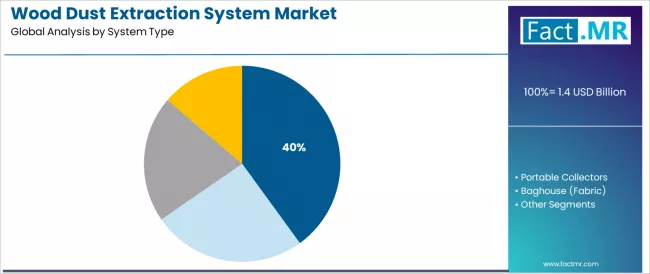
The centralized ducted segment is projected to maintain its leading position in the wood dust extraction system market in 2025 with a 40.0% market share, reaffirming its role as the preferred system configuration for large-scale industrial wood processing facilities and integrated manufacturing operations.
Facility operators and manufacturing companies increasingly utilize centralized ducted systems for their comprehensive coverage capabilities, operational efficiency benefits, and proven effectiveness in managing multiple dust collection points while maintaining centralized control and maintenance procedures. Centralized ducted technology's proven effectiveness and scalability directly address industry requirements for comprehensive air quality management and cost-effective operation across diverse woodworking applications and facility sizes.
This system segment forms the foundation of modern industrial dust extraction, as it represents the configuration with the greatest contribution to comprehensive air quality management and established performance record across multiple facility types and production scales.
Woodworking industry investments in centralized dust extraction technologies continue to strengthen adoption among manufacturers and large-scale facilities. With industrial requirements demanding comprehensive coverage and operational efficiency, centralized ducted systems align with both safety objectives and cost optimization requirements, making them the central component of comprehensive air quality management strategies.
By Airflow Capacity, the 2,001-10,000 m³/h Segment Dominates Market Demand
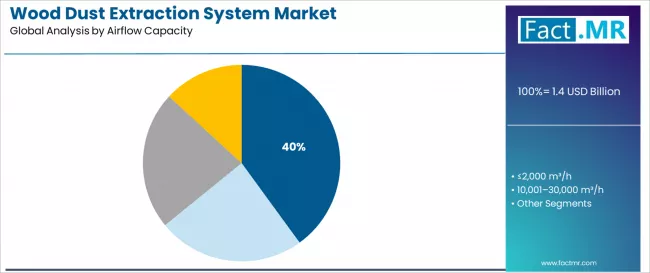
The 2,001-10,000 m³/h airflow capacity segment is projected to represent the largest share of wood dust extraction system demand in 2025 with a 40.0% market share, underscoring its critical role as the optimal capacity range for medium-scale woodworking operations and diverse manufacturing applications.
Facility operators prefer this capacity range for wood dust extraction due to its balanced performance characteristics, cost effectiveness, and proven effectiveness in handling typical production volumes while supporting flexible operation requirements and diverse equipment configurations. Positioned as the optimal capacity for most applications, the 2,001-10,000 m³/h range offers both performance adequacy and cost efficiency advantages.
The segment is supported by continuous innovation in system efficiency and the growing availability of modular capacity systems that enable superior performance scaling with enhanced energy efficiency and maintenance simplicity.
System manufacturers are investing in comprehensive capacity optimization programs to support increasingly diverse facility requirements and operational flexibility demands. As facility complexity increases and energy efficiency becomes more important, the 2,001-10,000 m³/h capacity range will continue to dominate the market while supporting advanced system integration and operational optimization strategies.
What are the Drivers, Restraints, and Key Trends of the Wood Dust Extraction System Market?
The wood dust extraction system market is advancing steadily due to increasing regulatory enforcement of workplace safety standards driven by occupational health awareness and liability concerns, alongside growing demand for comprehensive dust management solutions that provide worker protection, environmental compliance, and operational efficiency across various woodworking and manufacturing applications. However, the market faces challenges, including high initial investment costs for comprehensive systems, energy consumption concerns for continuous operation, and maintenance complexity for large-scale installations. Innovation in energy-efficient technologies and smart monitoring systems continues to influence system adoption and operational optimization patterns.
Expansion of Regulatory Enforcement and Safety Standards
The growing enforcement of occupational safety regulations is driving demand for wood dust extraction systems that can ensure compliance with workplace air quality standards, protect workers from respiratory hazards, and support comprehensive health and safety management through advanced filtration and monitoring technologies. Manufacturing facilities require sophisticated dust extraction systems that deliver regulatory compliance across multiple safety parameters while maintaining operational efficiency and cost effectiveness. Facility operators are increasingly recognizing the liability advantages of comprehensive dust extraction implementation for worker protection and regulatory compliance, creating opportunities for advanced systems designed for stringent safety requirements and regulatory documentation.
Integration of Smart Monitoring and IoT Technologies
Modern wood dust extraction system manufacturers are incorporating smart monitoring technologies and IoT capabilities to enhance system performance, enable predictive maintenance, and support comprehensive operational optimization through real-time data collection and automated control systems. Leading companies are developing intelligent monitoring systems, implementing remote diagnostics capabilities, and advancing automation technologies that optimize dust extraction performance while reducing maintenance requirements and operational costs. These technologies improve system reliability while enabling new operational opportunities, including predictive maintenance, energy optimization, and comprehensive facility management integration.
Development of Energy-Efficient and Sustainable Technologies
The expansion of energy cost concerns and environmental consciousness is driving demand for energy-efficient wood dust extraction systems with reduced power consumption, optimized airflow management, and sustainable operation characteristics that address operational cost pressures and environmental compliance requirements. These advanced systems require sophisticated engineering capabilities and energy optimization technologies that exceed traditional dust extraction equipment requirements, creating premium market segments with enhanced efficiency credentials. Manufacturers are investing in energy optimization research and sustainable technology development to serve cost-conscious applications while supporting innovation in green manufacturing and environmental compliance.
Analysis of the Wood Dust Extraction System Market by Key Countries
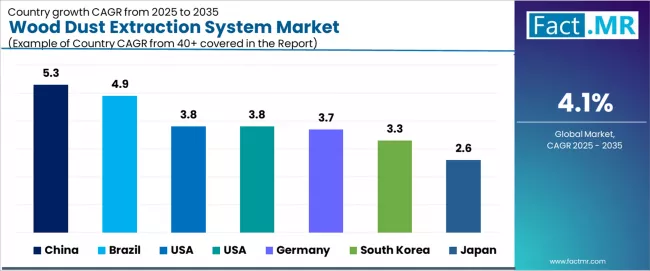
| Country | CAGR (2025-2035) |
|---|---|
| China | 5.3% |
| Brazil | 4.9% |
| USA | 3.8% |
| UK | 3.8% |
| Germany | 3.7% |
| South Korea | 3.3% |
| Japan | 2.6% |
The wood dust extraction system market is experiencing solid growth globally, with China leading at a 5.3% CAGR through 2035, driven by expanding furniture manufacturing capacity, increasing regulatory enforcement, and growing workplace safety awareness supporting equipment adoption.
Brazil follows at 4.9%, supported by developing wood processing industry, expanding furniture exports, and increasing safety regulation implementation. Europe shows growth at 3.9%, emphasizing advanced safety standards, environmental regulations, and comprehensive worker protection requirements.
The USA demonstrates 3.8% growth, supported by stringent OSHA regulations, liability concerns, and advanced safety system adoption. The UK records 3.8%, focusing on workplace safety compliance and environmental protection. Germany exhibits 3.7% growth, emphasizing engineering excellence and premium safety equipment.
South Korea shows 3.3% growth, supported by industrial modernization and safety standard adoption. Japan demonstrates 2.6% growth, focusing on precision equipment and advanced safety technologies.
China Leads Global Market Growth with Manufacturing Expansion
Revenue from wood dust extraction systems in China is projected to exhibit exceptional growth with a CAGR of 5.3% through 2035, driven by massive furniture manufacturing expansion and rapidly increasing regulatory enforcement supporting safety equipment adoption among wood processing facilities, furniture manufacturers, and industrial operations. The country's extensive woodworking industry development and increasing workplace safety awareness are creating substantial demand for dust extraction system solutions. Major furniture manufacturers and wood processing companies are establishing comprehensive safety management capabilities to serve both domestic markets and export compliance requirements.
- Strong furniture manufacturing growth and export market development are driving demand for wood dust extraction systems throughout major manufacturing regions and industrial clusters across furniture plants, wood processing facilities, and manufacturing centers.
- Growing regulatory enforcement and workplace safety awareness are supporting the rapid adoption of comprehensive dust extraction technologies among manufacturers seeking regulatory compliance and worker protection in competitive international markets.
Brazil Demonstrates Strong Market Potential with Industry Development
Revenue from wood dust extraction systems in Brazil is expanding at a CAGR of 4.9%, supported by the country's developing wood processing industry, expanding furniture export markets, and increasing implementation of safety regulations and workplace protection standards. The country's natural resource advantages and growing manufacturing sophistication are driving demand for advanced dust extraction systems throughout various industrial sectors. Leading furniture manufacturers and wood processors are establishing comprehensive safety management facilities to address growing regulatory requirements and export market standards.
- Strong wood processing industry development and expanding furniture exports are creating opportunities for dust extraction system adoption across manufacturing facilities, furniture producers, and wood processing centers in major industrial regions.
- Growing safety regulation implementation and workplace protection awareness are driving adoption of comprehensive dust management technologies among manufacturers seeking regulatory compliance and competitive positioning in international markets.
USA Focuses on Regulatory Compliance and Liability Protection
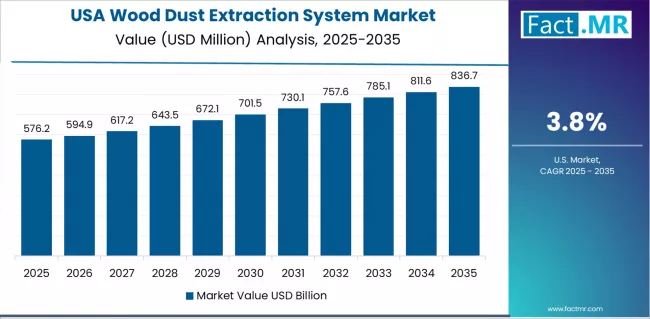
Revenue from wood dust extraction systems in the USA is expanding at a CAGR of 3.8%, driven by the country's stringent OSHA regulations, liability protection concerns, and advanced safety system adoption supporting comprehensive workplace air quality management. The USA's regulatory enforcement and liability awareness are supporting investment in advanced dust extraction technologies. Major manufacturing companies and facility operators are establishing comprehensive safety compliance programs incorporating advanced dust extraction equipment.
- Stringent OSHA regulations and liability protection concerns are creating demand for comprehensive dust extraction systems throughout woodworking facilities, furniture manufacturers, and industrial operations across major manufacturing regions.
- Strong safety culture and regulatory compliance focus are driving the adoption of advanced dust extraction technologies among manufacturers seeking worker protection and liability risk reduction in competitive industrial markets.
UK Shows Market Leadership with Workplace Safety Focus
Revenue from wood dust extraction systems in the UK is expanding at a CAGR of 3.8%, supported by the country's workplace safety compliance requirements, environmental protection standards, and comprehensive health and safety management supporting dust extraction system adoption across manufacturing applications. The UK's safety regulation enforcement and health awareness are driving demand for effective dust extraction solutions. Leading manufacturing companies and facility operators are investing in comprehensive air quality management and worker protection systems.
- Workplace safety compliance requirements and environmental protection standards are creating opportunities for dust extraction systems throughout manufacturing facilities, woodworking operations, and industrial facilities serving safety-focused market segments.
- Strong health and safety culture and regulatory enforcement are driving the adoption of comprehensive dust management systems across production facilities seeking enhanced worker protection and regulatory compliance assurance.
Germany Demonstrates Engineering Excellence with Premium Safety Equipment
Revenue from wood dust extraction systems in Germany is expanding at a CAGR of 3.7%, supported by the country's engineering excellence, premium safety equipment development capabilities, and advanced manufacturing standards supporting sophisticated dust extraction system production and utilization. The nation's engineering expertise and quality focus are driving demand for premium dust extraction solutions. Leading equipment manufacturers are investing extensively in advanced technology development and precision safety equipment manufacturing.
- Advanced engineering capabilities and premium equipment focus are creating demand for sophisticated dust extraction systems throughout high-end manufacturing facilities and precision woodworking operations serving premium safety market segments.
- Strong equipment development expertise and quality standards are supporting the adoption of precision dust extraction equipment designed for advanced manufacturing applications and specialized worker protection requirements.
South Korea Demonstrates Industrial Modernization with Safety Integration
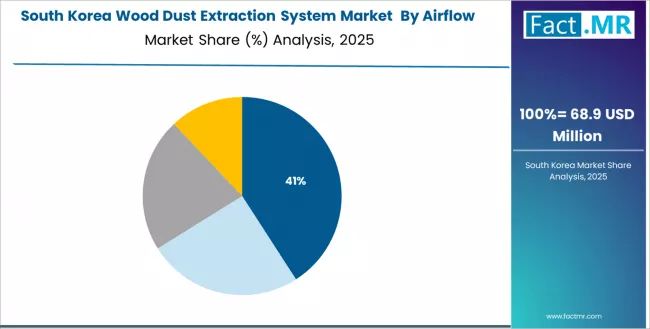
Revenue from wood dust extraction systems in South Korea is expanding at a CAGR of 3.3%, supported by the country's industrial modernization initiatives, safety standard adoption, and growing emphasis on workplace protection and environmental compliance supporting dust extraction equipment integration. The nation's manufacturing advancement and safety consciousness are driving demand for modern dust extraction solutions. Leading manufacturing companies are investing extensively in facility modernization and comprehensive safety system implementation.
- Industrial modernization initiatives and safety standard adoption are creating demand for modern dust extraction systems throughout manufacturing facilities and wood processing operations seeking technological advancement and regulatory compliance.
- Strong manufacturing development and workplace protection focus are supporting the adoption of integrated dust extraction systems designed for advanced production requirements and comprehensive safety management.
Japan Shows Premium Focus with Precision Safety Technologies
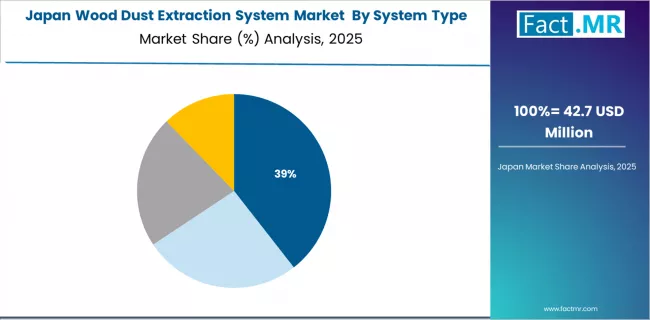
Revenue from wood dust extraction systems in Japan is expanding at a CAGR of 2.6%, supported by the country's precision equipment excellence, advanced safety technology development, and strong emphasis on quality and technological innovation supporting premium dust extraction system utilization. Japan's technological sophistication and safety consciousness are driving demand for precision dust extraction products. Leading technology companies are investing in specialized capabilities for advanced safety equipment applications and precision technology development.
- Advanced precision manufacturing and safety technology focus are creating opportunities for premium dust extraction systems throughout high-end manufacturing facilities and precision woodworking operations serving specialized safety applications.
- Strong technology innovation and precision equipment emphasis are driving adoption of advanced dust extraction systems meeting Japanese manufacturing standards for excellence and technological sophistication across diverse industrial applications.
Europe Market Split by Country
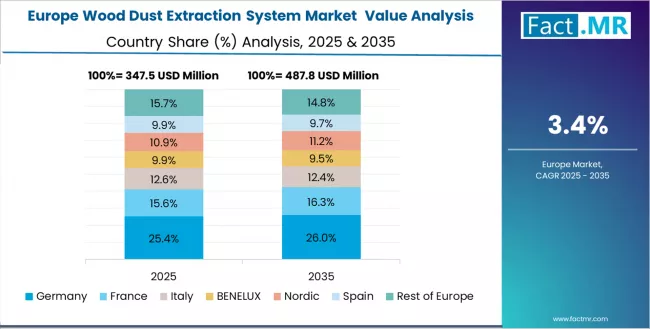
The wood dust extraction system market in Europe is projected to grow from USD 502.9 million in 2025 to USD 720.0 million by 2035, registering a CAGR of 3.9% over the forecast period. Germany is expected to maintain leadership with a 29.8% market share in 2025, moderating to 29.5% by 2035, supported by engineering excellence, premium equipment development, and advanced safety standards.
Italy follows with 21.4% in 2025, projected to reach 21.6% by 2035, driven by furniture industry leadership, woodworking traditions, and comprehensive safety compliance requirements. France holds 17.9% in 2025, expected to reach 18.0% by 2035 due to regulatory enforcement and workplace protection standards. The United Kingdom commands 15.5% in 2025, rising to 15.6% by 2035, while Spain accounts for 9.7% in 2025, reaching 9.8% by 2035. The Rest of Europe region is anticipated to hold 5.7% in 2025 and 5.5% by 2035, reflecting steady safety equipment adoption in Nordic countries and emerging industrial safety markets in Eastern European countries.
Competitive Landscape of the Wood Dust Extraction System Market
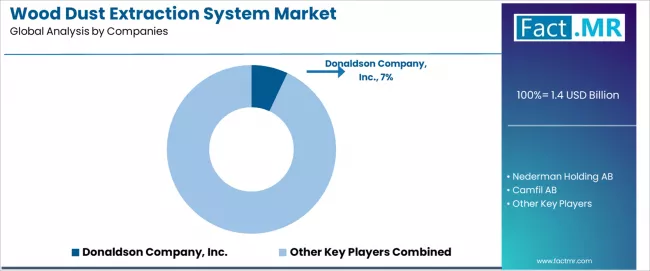
The wood dust extraction system market is characterized by competition among established industrial equipment manufacturers, specialized air filtration companies, and comprehensive environmental solution providers. Companies are investing in energy efficiency development, smart monitoring technology advancement, filtration performance improvement, and comprehensive service capabilities to deliver high-performance, reliable, and cost-effective dust extraction solutions. Innovation in IoT integration, predictive maintenance capabilities, and sustainable operation technologies is central to strengthening market position and competitive advantage.
Donaldson leads the market with a 7.0% share, offering comprehensive wood dust extraction solutions with focus on advanced filtration technology, energy efficiency optimization, and extensive global service networks serving diverse woodworking and manufacturing applications. The company continues investing in smart monitoring technologies and sustainable filtration solutions while expanding production capacity and technical support capabilities.
Nederman provides comprehensive industrial air filtration solutions with emphasis on workplace safety and environmental compliance. Camfil specializes in high-efficiency air filtration and clean air technologies. Scheuch focuses on industrial dust extraction and material handling systems. Höcker Polytechnik emphasizes woodworking industry expertise and specialized solutions. Plymovent offers comprehensive extraction and filtration technologies.
Key Players in the Wood Dust Extraction System Market
- Donaldson Company, Inc.
- Nederman Holding AB
- Camfil AB
- Scheuch GmbH
- Höcker Polytechnik GmbH
- Plymovent Group
- Schuko GmbH & Co. KG
- ATS (Advanced Technology Services, Inc.)
- Felder Group
- Laguna Tools
Scope of the Report
| Items | Values |
|---|---|
| Quantitative Units (2025) | USD 1,400.0 Million |
| System Type | Centralized Ducted, Portable Collectors, Baghouse (Fabric), Cartridge/HEPA Systems |
| Airflow Capacity | ≤2,000 m³/h, 2,001-10,000 m³/h, 10,001-30,000 m³/h, >30,000 m³/h |
| End Use | Furniture & Cabinetry, Sawmills & Lumber, Modular/Panel Factories, Joinery/Small Shops |
| Filtration Media | Fabric Bags, Cartridge/PLEAT, HEPA/Secondary, Spark/Fire Safe & Other |
| Regions Covered | Asia-Pacific, Europe, North America, Latin America, Middle East & Africa |
| Countries Covered | China, Brazil, Germany, USA, UK, Japan, South Korea, and 40+ countries |
| Key Companies Profiled | Donaldson, Nederman, Camfil, Scheuch, Höcker Polytechnik, Plymovent |
| Additional Attributes | Dollar sales by system type and airflow capacity, regional demand trends, competitive landscape, technological advancements in dust extraction technology, smart monitoring development, energy efficiency innovation, and safety compliance optimization |
Wood Dust Extraction System Market by Segments
-
System Type :
- Centralized Ducted
- Portable Collectors
- Baghouse (Fabric)
- Cartridge/HEPA Systems
-
Airflow Capacity :
- ≤2,000 m³/h
- 2,001-10,000 m³/h
- 10,001-30,000 m³/h
- 30,000 m³/h
-
End Use :
- Furniture & Cabinetry
- Sawmills & Lumber
- Modular/Panel Factories
- Joinery/Small Shops
-
Filtration Media :
- Fabric Bags
- Cartridge/PLEAT
- HEPA/Secondary
- Spark/Fire Safe & Other
-
Region :
- Asia-Pacific
- China
- Japan
- South Korea
- India
- Australia
- Rest of Asia-Pacific
- Europe
- Germany
- United Kingdom
- France
- Italy
- Spain
- Netherlands
- Rest of Europe
- North America
- United States
- Canada
- Mexico
- Latin America
- Brazil
- Argentina
- Rest of Latin America
- Middle East & Africa
- Kingdom of Saudi Arabia
- South Africa
- Rest of Middle East & Africa
- Asia-Pacific
Table of Content
- Executive Summary
- Global Market Outlook
- Demand to side Trends
- Supply to side Trends
- Technology Roadmap Analysis
- Analysis and Recommendations
- Market Overview
- Market Coverage / Taxonomy
- Market Definition / Scope / Limitations
- Market Background
- Market Dynamics
- Drivers
- Restraints
- Opportunity
- Trends
- Scenario Forecast
- Demand in Optimistic Scenario
- Demand in Likely Scenario
- Demand in Conservative Scenario
- Opportunity Map Analysis
- Product Life Cycle Analysis
- Supply Chain Analysis
- Investment Feasibility Matrix
- Value Chain Analysis
- PESTLE and Porter’s Analysis
- Regulatory Landscape
- Regional Parent Market Outlook
- Production and Consumption Statistics
- Import and Export Statistics
- Market Dynamics
- Global Market Analysis 2020 to 2024 and Forecast, 2025 to 2035
- Historical Market Size Value (USD Million) Analysis, 2020 to 2024
- Current and Future Market Size Value (USD Million) Projections, 2025 to 2035
- Y to o to Y Growth Trend Analysis
- Absolute $ Opportunity Analysis
- Global Market Pricing Analysis 2020 to 2024 and Forecast 2025 to 2035
- Global Market Analysis 2020 to 2024 and Forecast 2025 to 2035, By System Type
- Introduction / Key Findings
- Historical Market Size Value (USD Million) Analysis By System Type , 2020 to 2024
- Current and Future Market Size Value (USD Million) Analysis and Forecast By System Type , 2025 to 2035
- Centralized Ducted
- Portable Collectors
- Baghouse (Fabric)
- Cartridge/HEPA Systems
- Y to o to Y Growth Trend Analysis By System Type , 2020 to 2024
- Absolute $ Opportunity Analysis By System Type , 2025 to 2035
- Global Market Analysis 2020 to 2024 and Forecast 2025 to 2035, By Airflow Capacity
- Introduction / Key Findings
- Historical Market Size Value (USD Million) Analysis By Airflow Capacity, 2020 to 2024
- Current and Future Market Size Value (USD Million) Analysis and Forecast By Airflow Capacity, 2025 to 2035
- 2,001-10,000 m³/h
- ≤2,000 m³/h
- 10,001-30,000 m³/h
- 30,000 m³/h
- Y to o to Y Growth Trend Analysis By Airflow Capacity, 2020 to 2024
- Absolute $ Opportunity Analysis By Airflow Capacity, 2025 to 2035
- Global Market Analysis 2020 to 2024 and Forecast 2025 to 2035, By Region
- Introduction
- Historical Market Size Value (USD Million) Analysis By Region, 2020 to 2024
- Current Market Size Value (USD Million) Analysis and Forecast By Region, 2025 to 2035
- North America
- Latin America
- Western Europe
- Eastern Europe
- East Asia
- South Asia and Pacific
- Middle East & Africa
- Market Attractiveness Analysis By Region
- North America Market Analysis 2020 to 2024 and Forecast 2025 to 2035, By Country
- Historical Market Size Value (USD Million) Trend Analysis By Market Taxonomy, 2020 to 2024
- Market Size Value (USD Million) Forecast By Market Taxonomy, 2025 to 2035
- By Country
- USA
- Canada
- Mexico
- By System Type
- By Airflow Capacity
- By Country
- Market Attractiveness Analysis
- By Country
- By System Type
- By Airflow Capacity
- Key Takeaways
- Latin America Market Analysis 2020 to 2024 and Forecast 2025 to 2035, By Country
- Historical Market Size Value (USD Million) Trend Analysis By Market Taxonomy, 2020 to 2024
- Market Size Value (USD Million) Forecast By Market Taxonomy, 2025 to 2035
- By Country
- Brazil
- Chile
- Rest of Latin America
- By System Type
- By Airflow Capacity
- By Country
- Market Attractiveness Analysis
- By Country
- By System Type
- By Airflow Capacity
- Key Takeaways
- Western Europe Market Analysis 2020 to 2024 and Forecast 2025 to 2035, By Country
- Historical Market Size Value (USD Million) Trend Analysis By Market Taxonomy, 2020 to 2024
- Market Size Value (USD Million) Forecast By Market Taxonomy, 2025 to 2035
- By Country
- Germany
- UK
- Italy
- Spain
- France
- Nordic
- BENELUX
- Rest of Western Europe
- By System Type
- By Airflow Capacity
- By Country
- Market Attractiveness Analysis
- By Country
- By System Type
- By Airflow Capacity
- Key Takeaways
- Eastern Europe Market Analysis 2020 to 2024 and Forecast 2025 to 2035, By Country
- Historical Market Size Value (USD Million) Trend Analysis By Market Taxonomy, 2020 to 2024
- Market Size Value (USD Million) Forecast By Market Taxonomy, 2025 to 2035
- By Country
- Russia
- Poland
- Hungary
- Balkan & Baltic
- Rest of Eastern Europe
- By System Type
- By Airflow Capacity
- By Country
- Market Attractiveness Analysis
- By Country
- By System Type
- By Airflow Capacity
- Key Takeaways
- East Asia Market Analysis 2020 to 2024 and Forecast 2025 to 2035, By Country
- Historical Market Size Value (USD Million) Trend Analysis By Market Taxonomy, 2020 to 2024
- Market Size Value (USD Million) Forecast By Market Taxonomy, 2025 to 2035
- By Country
- China
- Japan
- South Korea
- By System Type
- By Airflow Capacity
- By Country
- Market Attractiveness Analysis
- By Country
- By System Type
- By Airflow Capacity
- Key Takeaways
- South Asia and Pacific Market Analysis 2020 to 2024 and Forecast 2025 to 2035, By Country
- Historical Market Size Value (USD Million) Trend Analysis By Market Taxonomy, 2020 to 2024
- Market Size Value (USD Million) Forecast By Market Taxonomy, 2025 to 2035
- By Country
- India
- ASEAN
- Australia & New Zealand
- Rest of South Asia and Pacific
- By System Type
- By Airflow Capacity
- By Country
- Market Attractiveness Analysis
- By Country
- By System Type
- By Airflow Capacity
- Key Takeaways
- Middle East & Africa Market Analysis 2020 to 2024 and Forecast 2025 to 2035, By Country
- Historical Market Size Value (USD Million) Trend Analysis By Market Taxonomy, 2020 to 2024
- Market Size Value (USD Million) Forecast By Market Taxonomy, 2025 to 2035
- By Country
- Kingdom of Saudi Arabia
- Other GCC Countries
- Turkiye
- South Africa
- Other African Union
- Rest of Middle East & Africa
- By System Type
- By Airflow Capacity
- By Country
- Market Attractiveness Analysis
- By Country
- By System Type
- By Airflow Capacity
- Key Takeaways
- Key Countries Market Analysis
- USA
- Pricing Analysis
- Market Share Analysis, 2024
- By System Type
- By Airflow Capacity
- Canada
- Pricing Analysis
- Market Share Analysis, 2024
- By System Type
- By Airflow Capacity
- Mexico
- Pricing Analysis
- Market Share Analysis, 2024
- By System Type
- By Airflow Capacity
- Brazil
- Pricing Analysis
- Market Share Analysis, 2024
- By System Type
- By Airflow Capacity
- Chile
- Pricing Analysis
- Market Share Analysis, 2024
- By System Type
- By Airflow Capacity
- Germany
- Pricing Analysis
- Market Share Analysis, 2024
- By System Type
- By Airflow Capacity
- UK
- Pricing Analysis
- Market Share Analysis, 2024
- By System Type
- By Airflow Capacity
- Italy
- Pricing Analysis
- Market Share Analysis, 2024
- By System Type
- By Airflow Capacity
- Spain
- Pricing Analysis
- Market Share Analysis, 2024
- By System Type
- By Airflow Capacity
- France
- Pricing Analysis
- Market Share Analysis, 2024
- By System Type
- By Airflow Capacity
- India
- Pricing Analysis
- Market Share Analysis, 2024
- By System Type
- By Airflow Capacity
- ASEAN
- Pricing Analysis
- Market Share Analysis, 2024
- By System Type
- By Airflow Capacity
- Australia & New Zealand
- Pricing Analysis
- Market Share Analysis, 2024
- By System Type
- By Airflow Capacity
- China
- Pricing Analysis
- Market Share Analysis, 2024
- By System Type
- By Airflow Capacity
- Japan
- Pricing Analysis
- Market Share Analysis, 2024
- By System Type
- By Airflow Capacity
- South Korea
- Pricing Analysis
- Market Share Analysis, 2024
- By System Type
- By Airflow Capacity
- Russia
- Pricing Analysis
- Market Share Analysis, 2024
- By System Type
- By Airflow Capacity
- Poland
- Pricing Analysis
- Market Share Analysis, 2024
- By System Type
- By Airflow Capacity
- Hungary
- Pricing Analysis
- Market Share Analysis, 2024
- By System Type
- By Airflow Capacity
- Kingdom of Saudi Arabia
- Pricing Analysis
- Market Share Analysis, 2024
- By System Type
- By Airflow Capacity
- Turkiye
- Pricing Analysis
- Market Share Analysis, 2024
- By System Type
- By Airflow Capacity
- South Africa
- Pricing Analysis
- Market Share Analysis, 2024
- By System Type
- By Airflow Capacity
- USA
- Market Structure Analysis
- Competition Dashboard
- Competition Benchmarking
- Market Share Analysis of Top Players
- By Regional
- By System Type
- By Airflow Capacity
- Competition Analysis
- Competition Deep Dive
- Donaldson Company, Inc.
- Overview
- Product Portfolio
- Profitability by Market Segments (Product/Age /Sales Channel/Region)
- Sales Footprint
- Strategy Overview
- Marketing Strategy
- Product Strategy
- Channel Strategy
- Nederman Holding AB
- Camfil AB
- Scheuch GmbH
- Höcker Polytechnik GmbH
- Plymovent Group
- Schuko GmbH & Co. KG
- ATS (Advanced Technology Services, Inc.)
- Felder Group
- Laguna Tools
- Donaldson Company, Inc.
- Competition Deep Dive
- Assumptions & Acronyms Used
- Research Methodology
List Of Table
- Table 1: Global Market Value (USD Million) Forecast by Region, 2020 to 2035
- Table 2: Global Market Value (USD Million) Forecast by System Type , 2020 to 2035
- Table 3: Global Market Value (USD Million) Forecast by Airflow Capacity, 2020 to 2035
- Table 4: North America Market Value (USD Million) Forecast by Country, 2020 to 2035
- Table 5: North America Market Value (USD Million) Forecast by System Type , 2020 to 2035
- Table 6: North America Market Value (USD Million) Forecast by Airflow Capacity, 2020 to 2035
- Table 7: Latin America Market Value (USD Million) Forecast by Country, 2020 to 2035
- Table 8: Latin America Market Value (USD Million) Forecast by System Type , 2020 to 2035
- Table 9: Latin America Market Value (USD Million) Forecast by Airflow Capacity, 2020 to 2035
- Table 10: Western Europe Market Value (USD Million) Forecast by Country, 2020 to 2035
- Table 11: Western Europe Market Value (USD Million) Forecast by System Type , 2020 to 2035
- Table 12: Western Europe Market Value (USD Million) Forecast by Airflow Capacity, 2020 to 2035
- Table 13: Eastern Europe Market Value (USD Million) Forecast by Country, 2020 to 2035
- Table 14: Eastern Europe Market Value (USD Million) Forecast by System Type , 2020 to 2035
- Table 15: Eastern Europe Market Value (USD Million) Forecast by Airflow Capacity, 2020 to 2035
- Table 16: East Asia Market Value (USD Million) Forecast by Country, 2020 to 2035
- Table 17: East Asia Market Value (USD Million) Forecast by System Type , 2020 to 2035
- Table 18: East Asia Market Value (USD Million) Forecast by Airflow Capacity, 2020 to 2035
- Table 19: South Asia and Pacific Market Value (USD Million) Forecast by Country, 2020 to 2035
- Table 20: South Asia and Pacific Market Value (USD Million) Forecast by System Type , 2020 to 2035
- Table 21: South Asia and Pacific Market Value (USD Million) Forecast by Airflow Capacity, 2020 to 2035
- Table 22: Middle East & Africa Market Value (USD Million) Forecast by Country, 2020 to 2035
- Table 23: Middle East & Africa Market Value (USD Million) Forecast by System Type , 2020 to 2035
- Table 24: Middle East & Africa Market Value (USD Million) Forecast by Airflow Capacity, 2020 to 2035
List Of Figures
- Figure 1: Global Market Pricing Analysis
- Figure 2: Global Market Value (USD Million) Forecast 2020-2035
- Figure 3: Global Market Value Share and BPS Analysis by System Type , 2025 and 2035
- Figure 4: Global Market Y to o to Y Growth Comparison by System Type , 2025-2035
- Figure 5: Global Market Attractiveness Analysis by System Type
- Figure 6: Global Market Value Share and BPS Analysis by Airflow Capacity, 2025 and 2035
- Figure 7: Global Market Y to o to Y Growth Comparison by Airflow Capacity, 2025-2035
- Figure 8: Global Market Attractiveness Analysis by Airflow Capacity
- Figure 9: Global Market Value (USD Million) Share and BPS Analysis by Region, 2025 and 2035
- Figure 10: Global Market Y to o to Y Growth Comparison by Region, 2025-2035
- Figure 11: Global Market Attractiveness Analysis by Region
- Figure 12: North America Market Incremental Dollar Opportunity, 2025-2035
- Figure 13: Latin America Market Incremental Dollar Opportunity, 2025-2035
- Figure 14: Western Europe Market Incremental Dollar Opportunity, 2025-2035
- Figure 15: Eastern Europe Market Incremental Dollar Opportunity, 2025-2035
- Figure 16: East Asia Market Incremental Dollar Opportunity, 2025-2035
- Figure 17: South Asia and Pacific Market Incremental Dollar Opportunity, 2025-2035
- Figure 18: Middle East & Africa Market Incremental Dollar Opportunity, 2025-2035
- Figure 19: North America Market Value Share and BPS Analysis by Country, 2025 and 2035
- Figure 20: North America Market Value Share and BPS Analysis by System Type , 2025 and 2035
- Figure 21: North America Market Y to o to Y Growth Comparison by System Type , 2025-2035
- Figure 22: North America Market Attractiveness Analysis by System Type
- Figure 23: North America Market Value Share and BPS Analysis by Airflow Capacity, 2025 and 2035
- Figure 24: North America Market Y to o to Y Growth Comparison by Airflow Capacity, 2025-2035
- Figure 25: North America Market Attractiveness Analysis by Airflow Capacity
- Figure 26: Latin America Market Value Share and BPS Analysis by Country, 2025 and 2035
- Figure 27: Latin America Market Value Share and BPS Analysis by System Type , 2025 and 2035
- Figure 28: Latin America Market Y to o to Y Growth Comparison by System Type , 2025-2035
- Figure 29: Latin America Market Attractiveness Analysis by System Type
- Figure 30: Latin America Market Value Share and BPS Analysis by Airflow Capacity, 2025 and 2035
- Figure 31: Latin America Market Y to o to Y Growth Comparison by Airflow Capacity, 2025-2035
- Figure 32: Latin America Market Attractiveness Analysis by Airflow Capacity
- Figure 33: Western Europe Market Value Share and BPS Analysis by Country, 2025 and 2035
- Figure 34: Western Europe Market Value Share and BPS Analysis by System Type , 2025 and 2035
- Figure 35: Western Europe Market Y to o to Y Growth Comparison by System Type , 2025-2035
- Figure 36: Western Europe Market Attractiveness Analysis by System Type
- Figure 37: Western Europe Market Value Share and BPS Analysis by Airflow Capacity, 2025 and 2035
- Figure 38: Western Europe Market Y to o to Y Growth Comparison by Airflow Capacity, 2025-2035
- Figure 39: Western Europe Market Attractiveness Analysis by Airflow Capacity
- Figure 40: Eastern Europe Market Value Share and BPS Analysis by Country, 2025 and 2035
- Figure 41: Eastern Europe Market Value Share and BPS Analysis by System Type , 2025 and 2035
- Figure 42: Eastern Europe Market Y to o to Y Growth Comparison by System Type , 2025-2035
- Figure 43: Eastern Europe Market Attractiveness Analysis by System Type
- Figure 44: Eastern Europe Market Value Share and BPS Analysis by Airflow Capacity, 2025 and 2035
- Figure 45: Eastern Europe Market Y to o to Y Growth Comparison by Airflow Capacity, 2025-2035
- Figure 46: Eastern Europe Market Attractiveness Analysis by Airflow Capacity
- Figure 47: East Asia Market Value Share and BPS Analysis by Country, 2025 and 2035
- Figure 48: East Asia Market Value Share and BPS Analysis by System Type , 2025 and 2035
- Figure 49: East Asia Market Y to o to Y Growth Comparison by System Type , 2025-2035
- Figure 50: East Asia Market Attractiveness Analysis by System Type
- Figure 51: East Asia Market Value Share and BPS Analysis by Airflow Capacity, 2025 and 2035
- Figure 52: East Asia Market Y to o to Y Growth Comparison by Airflow Capacity, 2025-2035
- Figure 53: East Asia Market Attractiveness Analysis by Airflow Capacity
- Figure 54: South Asia and Pacific Market Value Share and BPS Analysis by Country, 2025 and 2035
- Figure 55: South Asia and Pacific Market Value Share and BPS Analysis by System Type , 2025 and 2035
- Figure 56: South Asia and Pacific Market Y to o to Y Growth Comparison by System Type , 2025-2035
- Figure 57: South Asia and Pacific Market Attractiveness Analysis by System Type
- Figure 58: South Asia and Pacific Market Value Share and BPS Analysis by Airflow Capacity, 2025 and 2035
- Figure 59: South Asia and Pacific Market Y to o to Y Growth Comparison by Airflow Capacity, 2025-2035
- Figure 60: South Asia and Pacific Market Attractiveness Analysis by Airflow Capacity
- Figure 61: Middle East & Africa Market Value Share and BPS Analysis by Country, 2025 and 2035
- Figure 62: Middle East & Africa Market Value Share and BPS Analysis by System Type , 2025 and 2035
- Figure 63: Middle East & Africa Market Y to o to Y Growth Comparison by System Type , 2025-2035
- Figure 64: Middle East & Africa Market Attractiveness Analysis by System Type
- Figure 65: Middle East & Africa Market Value Share and BPS Analysis by Airflow Capacity, 2025 and 2035
- Figure 66: Middle East & Africa Market Y to o to Y Growth Comparison by Airflow Capacity, 2025-2035
- Figure 67: Middle East & Africa Market Attractiveness Analysis by Airflow Capacity
- Figure 68: Global Market - Tier Structure Analysis
- Figure 69: Global Market - Company Share Analysis
- FAQs -
How big is the wood dust extraction system market in 2025?
The global wood dust extraction system market is estimated to be valued at USD 1.4 billion in 2025.
What will be the size of wood dust extraction system market in 2035?
The market size for the wood dust extraction system market is projected to reach USD 2.1 billion by 2035.
How much will be the wood dust extraction system market growth between 2025 and 2035?
The wood dust extraction system market is expected to grow at a 4.1?GR between 2025 and 2035.
What are the key product types in the wood dust extraction system market ?
The key product types in wood dust extraction system market are centralized ducted, portable collectors, baghouse (fabric) and cartridge/hepa systems.
Which airflow capacity segment to contribute significant share in the wood dust extraction system market in 2025?
In terms of airflow capacity, 2,001–10,000 m³/h segment to command 40.0% share in the wood dust extraction system market in 2025.